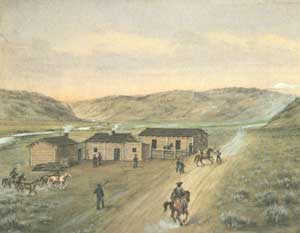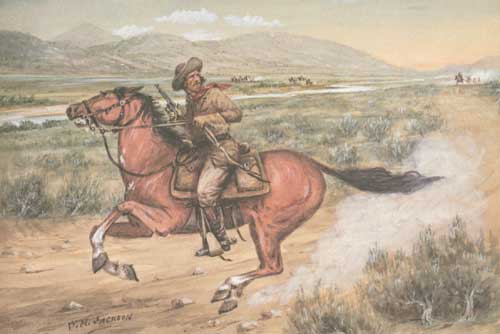
INTRODUCTION
By Marian Albright Schenk
FOREWORD
By Dean Knudsen
SECTION 1
Primary Themes of Jackson's Art
SECTION 2
Paintings of the Oregon Trail
SECTION 3
Historic Scenes From the West
 |
| William Henry Jackson's fascination with the American West never wavered, and he did much to instill that same interest in younger generations. A handwritten notation on the back of this photograph reads, "WHJ before high school class at Edison Institute, Ford Museum. Detroit 1936." (SCBL 2696) |

Section 1: Primary Themes of Jackson's Art
THE PONY EXPRESS
Few aspects of frontier history have captured the imaginations of Americans more than the Pony Express. Romantic images persist of a courageous lone rider, crossing a hostile wilderness with saddlebags full of vital letters, ignoring threats from marauding Indians and serving as a mainstay of civilization in the Far West throughout America's western expansion.
While this image has been the subject of hundreds of dime novels and Hollywood screenplays, in reality the Pony Express was designed as a stop-gap operation, intended to provide express mail delivery until the transcontinental telegraph line could be completed. In the short 18 months of its existence, the Pony Express lost so much money that it bankrupted its parent company—Russell, Majors and Waddell.1
 |
| Also known as Rocky Ridge Station, St. Mary's Station was located in an especially remote region in central Wyoming. It is interesting that Jackson chose to include several soldiers at the station, at a time when tensions between the North and South were building. (SCBL 34) |
The scope of the Pony Express operation was impressive. A total of 190 stations were established every twenty miles along the 1,600 mile route. Each of these stations was staffed and equipped to provide a fresh horse for each of the eighty riders who made a 120-mile ride before handing the mail off to the next man. In this manner, the mail could be delivered between St. Joseph, Missouri, to Sacramento, California, in just 10 days.
The first run was made on April 3, 1860, and the last was completed on November 20, 1861. The Pony Express has been credited with maintaining the ties between California and the Union in the early days of the Civil War. Although the Pony Express was a financial disaster, it did prove conclusively that the overland trail along the Platte River was an efficient and workable route that within a few years was also used by the transcontinental railroad.
Like so many members of his generation, William Henry Jackson was enamored of the Pony Express. The courage, commitment, and rugged sense of adventure that the Pony Express embodied was especially appealing to an artist, and Jackson did much to immortalize the achievements of the Pony Express. Pony Express riders, as well as the all-important home and relay stations were the subjects of many of his paintings.
Jackson's painting, Pony Express Rider, is probably one of his best-known works. Two notes on the back of the painting provide some interesting information about Jackson's subject. A handwritten note reads, "Ideal composition based on old notes and records," while a typed notation reads, "This courier of the first fast mail is speeding up the Valley of the Sweetwater in what is now Wyoming."
1. Raymond W. Settle and Mary Lund Settle, Saddles and Spurs (Harrisburg: The Stackpole Company, 1955), 176f.
 |
| Pony Express Rider. Signed and undated. 25.4 x 38.1 cm (SCBL 164) |
 |
scbl/knudsen/sec1a.htm Last Updated: 14-Apr-2006 |
 |